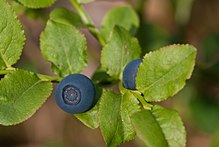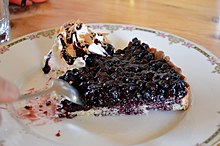Bilberry

Bilberries(/ˈbɪlbəri/) orblueberriesareEurasianlow-growingshrubsin the genusVacciniumin theflowering plantfamilyEricaceaethat bear edible, dark blue berries. The species most often referred to isVaccinium myrtillusL., but there are several other closely related species.
Etymology and common names
[edit]The name "bilberry" appears to have aScandinavianorigin, possibly from as early as 1577, being similar to the Danish wordbølleforwhortleberrywith the addition of "berry".[1]In Scandinavian languages, terms for bilberries have names that carry the meaning "blueberry": e.g.blåbärin Swedish andblåbærin Danish and Norwegian.[citation needed]
The bilberry (especiallyVaccinium myrtillus) is generally known asblaeberry/ˈbleɪbɛri/in Scottish and Northern English regional dialects,[2]andwhortleberry/ˈhwɜːrtəbri/in southern England.[2]
Description and species
[edit]This sectionneeds additional citations forverification.(January 2021) |


Bilberries —which are native to Europe— are different from North Americanblueberries,although the species are closely related and belong to the same genus,Vaccinium.Bilberry are non-climactericfruits with a smooth, circular outline at the end opposite the stalk, whereas blueberries retain persistentsepalsthere, leaving a rough, star-shaped pattern of five flaps.[3]Bilberries grow singly or in pairs rather than in clusters, as blueberries do, and blueberries have more evergreen leaves. Bilberries are dark in colour, and often appear near black with a slight shade of purple.
Bilberries and blueberries contain diverseanthocyanins,specificallyanthocyanidins,includingdelphinidinandcyanidinglycosides.[4][5]While blueberry fruit pulp is light green, bilberry is red or purple. The high anthocyanin content may cause staining of the fingers, lips, and tongue.[4]
Bilberries include several closely related species of the genusVaccinium,including:
- Vaccinium myrtillusL. (bilberry)
- Vaccinium uliginosumL. (bog bilberry, bog blueberry, bog whortleberry, bog huckleberry, northern bilberry, ground hurts)
- Vaccinium cespitosumMichx. (dwarf bilberry)
- Vaccinium deliciosumPiper (Cascade bilberry)
- Vaccinium membranaceum(mountain bilberry, black mountain huckleberry, black huckleberry, twin-leaved huckleberry)
- Vaccinium ovalifolium(oval-leafed blueberry, oval-leaved bilberry, mountain blueberry, high-bush blueberry).
These species, with the exception ofV. uliginosum,are part ofsectionMyrtillus.[6]
Wild and cultivated harvesting
[edit]This sectionneeds additional citations forverification.(January 2021) |

Bilberries are found inacidic,nutrient-poorsoilsthroughout thetemperateandsubarcticregions of the world. They are difficult to grow and the fruit is small, so they are seldom cultivated. Fruits are mostly collected from wild plants growing on publicly accessible lands throughout northern and central Europe where they are plentiful – for example, up to a fifth (17–21%) of the land area ofSwedencontains bilberry bushes, where it is called blåbär (lit. "blueberry", which is a source of confusion with the American blueberry).[7]Bilberries can be picked by aberry-picking rakelikelingonberries,but are more susceptible to damage. They are softer and juicier than blueberries, making them difficult to transport. Because of these factors, fresh bilberries are only available from markets and gourmet stores. Frozen bilberries, however, are available year round in many parts of Europe.
In Iceland, bilberries (known asaðalbláber,or "prime blueberry" ) grow predominantly inWestfjordsand the surrounding area. In most of the country, the closely relatedbláberoccupy the same habitat. Both species are commonly found growing withdwarf birchandcrowberries.Wild growth is vast compared to the population of Iceland and wild harvesting is legal, and a popular activity in August when the berry season peaks.
In Ireland, the fruit is known asfraughan,from theIrishfraochán,and is traditionally gathered on the last Sunday in July, known as "Fraughan Sunday". Bilberries were also collected at the Celtic festival ofLughnasadhin August, the first traditional harvest festival of the year. The crop of bilberries was said to indicate how well the rest of the crops would fare in their harvests later in the year.
Bilberry is used as a food plant by thelarvaeof someLepidopteraspecies (see the list of Lepidoptera that feed onVaccinium).
Food
[edit]
The fruits are eaten fresh or made intojams,fools,juices,orpies.In France and Italy, they are used as a base forliqueursand are a popular flavouring forsorbetsand other desserts. InBrittany,they are often used as a flavouring forcrêpes.In the Vosges and the Massif Central, bilberry tart (tarte aux myrtilles) is a traditional dessert. In Romania, they are used as a base for a liqueur calledafinată– the name of the fruit in Romanian isafină.In Nordic countries, they are eaten fresh or made into jams and other dishes, including bilberry pie (Finnishmustikkapiirakka,Swedishblåbärspaj) andblåbärssoppa,a bilberry soup served hot or cold. In Iceland they are popularly eaten withskyr(a cultured dairy product similar to yoghurt). In Poland, they are eaten fresh (often mixed with sugar), as a filling in a sweet yeast-leavened bun known asjagodzianka,in jams (known for their health benefits in the treatment ofdiarrhoea) and withśmietana(a soured cream) or unsoured cream as a sauce for rice or pasta for a light summertime meal.[citation needed]
Research
[edit]One review of low-qualityclinical researchconcluded there was no evidence that consuming bilberries improvesnight vision.[8]Bilberries have been used in a variety offolkloreandtraditional medicine,but there are no proven health benefits or anti-disease effects from consuming them.[9]
Diseases
[edit]Bilberry plants can suffer from bilberry blight,[10]caused byPhytophthora kernoviae.There have been severe outbreaks inStaffordshire,England.[11]
References
[edit]- ^"Bilberry".Merriam-Webster Dictionary.Merriam-Webster, Incorporated. 2016.Retrieved1 January2017.
- ^abBlamey, M.; Fitter, R.; Fitter, A (2003).Wildflowers of Britain and Ireland: The Complete Guide to the British and Irish Flora.London: A & C Black. p. 106.ISBN978-1-4081-7950-5.
- ^Voss, E.G. (1996).Michigan Flora Part III Dicots Concluded.Cranbrook Institute of Science. p. 46.ISBN1-877370-40-1.
- ^abBurdulis, D.; Ivanauskas, L.; Dirse, V.; Kazlauskas, S.; Razukas, A. (2007)."Study of diversity of anthocyanin composition in bilberry (Vaccinium myrtillus L.) fruits"(PDF).Medicina (Kaunas).43(12): 971–7.doi:10.3390/medicina43120127.PMID18182842.
- ^Lätti, A.K.; Riihinen, K.R.; Kainulainen, P.S. (2008). "Analysis of anthocyanin variation in wild populations of bilberry (Vaccinium myrtillus L.) in Finland".Journal of Agricultural and Food Chemistry.56(1): 190–6.doi:10.1021/jf072857m.PMID18072741.
- ^Kathleen A. Kron; E. Ann Powell; J. L. Luteyn (2002). "Phylogenetic relationships within the blueberry tribe (Vaccinieae, Ericaceae) based on sequence data from MATK and nuclear ribosomal ITS regions, with comments on the placement ofSatyria".American Journal of Botany.89(2): 327–336.doi:10.3732/ajb.89.2.327.PMID21669741.
- ^sv:Blåbär
- ^Canter, Peter H; Ernst, Edzard (2004). "Anthocyanosides of Vaccinium myrtillus (Bilberry) for Night Vision—A Systematic Review of Placebo-Controlled Trials".Survey of Ophthalmology.49(1): 38–50.doi:10.1016/j.survophthal.2003.10.006.ISSN0039-6257.PMID14711439.
- ^"Bilberry".National Center for Complementary and Integrative Health, US National Institutes of Health. September 2016.Retrieved26 January2018.
- ^"Phytophthora".Natural England.Archived fromthe originalon 27 March 2012.Retrieved26 June2011.
- ^"Disease of Bilberry (Phytophthora)".Staffordshire County Council.Archived fromthe originalon 27 January 2018.Retrieved26 January2018.

